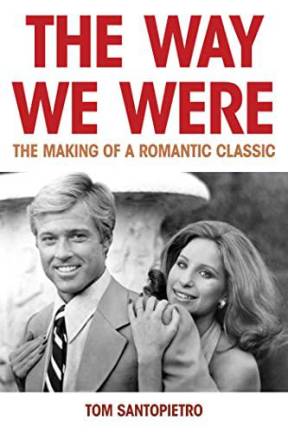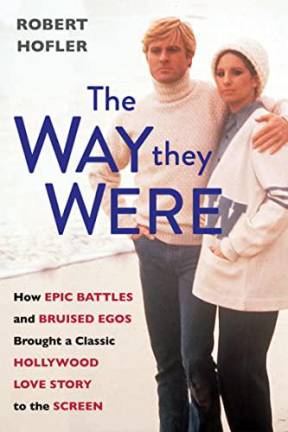Memories of the Way They Really Were as Classic Barbra/Redford Movie Turns 50
Two news books are hitting that celebrate the 50th anniversary of the Academy Award winning film, The Way We Were, starring Barbra Streisand and Robert Redford–now considered one of the greatest romantic dramas of all time.
“See ya, Hubbell,” she said.
“See you, Katie,” he said.
Okay, the lines are not “We’ll always have Paris”—but those are words that any romantic film connoisseur will instantly recognize. Think of Barbra Streisand stroking Robert Redford’s hair one last time and you’ll know what I’m talking about.
To commemorate the 50th anniversary of The Way We Were, not one but two books arrive: The Way We Were: The Making of a Romantic Classic, penned by Tom Santopietro; the other, The Way They Were: How Epic Battles and Bruised Egos Brought a Classic Hollywood Love Story to the Screen comes from Robert Hofler. Both men are New Yorkers, with long careers in the worlds of stage, screen and books. (Interestingly, both also wrote previous ones about Rock Hudson.)
Redford Worried He’d Be Seen As a ‘Ken Doll’
I asked Hofler how and why he commits to a subject. “I’m always looking for secrets in a story.” he says, “and then solving them.” In this case, he dove deep into the decisions, battles, and personal dynamics behind the scenes of the 1973 movie: Why Redford was reluctant–“I don’t want to be a Ken doll”–and why he finally relented; –past experiences with director Sydney Pollack. How the blacklisting was at first a bigger factor in the couple’s story; How Hubbel’s one night stand with an old girlfriend was originally a year-long one with a producer’s wife. As for those secrets Hofler likes to untangle? A key 11 minutes that resulted from back-to-back screenings before the movie opened.
One scene eliminated had no words, during which Katie, years later, drives by a campus and watches a girl giving an impassioned speech. “Pollack thought it was too spot-on, but Barbra thought it was about going back to her roots,” says Hofler. In fact, Pollack once told me it was because the actress had two crying scenes in a row and this would be a third. But he made a commitment to Streisand that it would go back in when the film had its first TV airing. (I revealed that story years later when writing a piece about tearjerkers)
Pollock was stunned that I noticed the new scene, but hey, that’s what happens when you’ve seen a movie as many times as I saw The Way We Were. “I can’t tell you how many times I’ve heard men say they didn’t like it, ‘but it’s my wife’s favorite movie,’ says Hofler. Even Sex And The City included a clear imitation in which Carrie and Mr. Big have a farewell outside the Plaza Hotel.
Santopietro says the key reason so many love the film is that “it’s the story of opposites attracting, which is inherently interesting. They do everything differently but they love each other wholeheartedly.”
He had written a previous book in 2006 about Streisand–The Importance of Being Barbra: The Brilliant and Tumultuous Career of Barbra Streisand. “I was fortunate enough to have a detailed exchange with her on this one,” he said. “The film holds a very special place in her life.” Hofler communicated by email with Streisand and Redford throughout his process and both authors spoke with others behind the scenes.
Hofler: Original Screenwriter Was “Chronic Liar”
Hofler comes down hardest on the original writer, Arthur Laurents, whom he said was “a chronic liar.” There’s even a semi-creepy claim that the Katie and Hubbell relationship was based on one Laurents had with a long-time beautiful blonde–gentile—partner. Santopietro adds, “Arthur Laurents was clearly unhappy with the changes made to his screenplay. They brought in eleven additional writers who were basically re-writing his life!”
Obviously, these books will be devoured only by folks who eat up any detail of the relationship between Katie Morosky—she Jewish, anti-war, politically active with the ironed hair and a love of FDR–and Hubbell Gardiner–he of the WASP-y perfect looks, limited writing skill and no particularly strong political beliefs. And the song? Well, it didn’t save the movie—as Tex Ritter’s did with High Noon after disastrous screenings–but it sure didn’t hurt. The score was written by Marvin Hamlisch and almost did not make it into the original cut. But after some rewriting it went back in–and became a number one hit single for Streisand in 1973 after the film’s release. As one principal in the production said, “anyone who can sing like that can cry all she wants.”
The chemistry between the stars, who were already superstars at the peak of their careers, was sufficient off screen as well. (Though Hofler’s research suggests that Streisand wanted Warren Beatty as her leading man.) All I know is she had no complaints. A realtor one day in 1972 brought a “Mrs. Gould” to see my family’s house In Malibu. Realizing who was behind the glasses and scarf, I mentioned that Robert Redford had rented the house previously. “He’s my co-star in this next movie!” she said. When I suggested, “Maybe you can co-live here,” she winked, “I wouldn’t mind!”
Michele Willens is the author of From Mouseketeers to Menopause
“The film holds a very special place in her life.” Robert Hofler, on Barbra’s Streisand’s view of The Way We Were.

